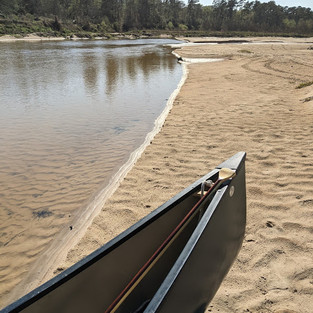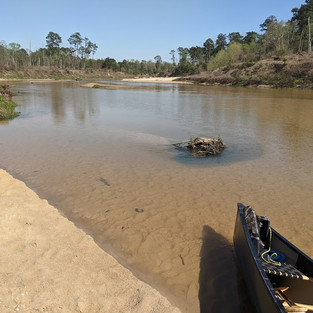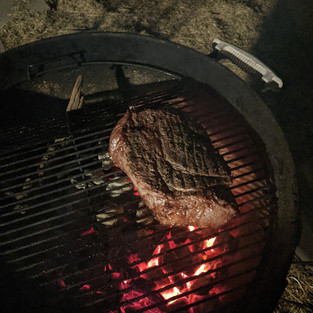
The Spring Creek paddle trail is an in town reprieve and a sanctuary for wilder things. We initially surveyed Spring Creek from the Pundt Park canoe launch while on a family picnic. Pundt Park is a well maintained facility with a police presence. I appreciate the efforts made by Harris County in these parks. There is little concern of automobile theft or vandalism in these parks. The illegal activities of trash dumping and graffiti painting is not present at these facilities.
The Pundt Park canoe launch is a generous sandbar with a portage trail leading to a blacktop access. In a conversation with the park police I learned that if you want to reduce the 250 or so yard portage you may call ahead and make reservations. The park attendees will unlock the gate, allowing you to drive closer to the creek with you gear. It is not required that you make reservations, unless you want to shorten the portage. The last thing I want to do is to task myself with a schedule while temporarily escaping the confines of the city. A 250 yard portage is no hill for a stepper!
These were my thoughts. We made plans to come back soon, and with a canoe. Dottie and I would make a date of it!
Between our picnic surveillance and the trip I studied satellite images of Spring Creek. I also researched Pundt and the Jesse H. Jones Park.
Upstream these parks is the launch at the old Riley Fuzzel bridge. The Pundt Park canoe launch is nearly three miles downstream from Riley Fuzzel. Eight and a half miles down from Pundt is the Jessie H. Jones canoe launch. Everything looked well laid out.
Before I had a chance to check out the Riley Fuzzel bridge or the Jessie H. Jones Park the trip snuck up on me. Compared to other paddle trails and launches the Spring Creek paddle trail looked well executed and polished. The websites of the county parks and my experience at Pundt park led me to high confidence.
The Launch:
Dottie and I hit new water on March 20, 2021. Saturday. By 2:10 we were in the Wenonah on Spring Creek and the Riley Fuzzel bridge was behind us. We paddled the clear water and quick currents over submerged sandbars. The take out at Pundt Park was a little over two and a half miles downstream. All is good.
While the highway traffic sounds were still dominant I heard the canoe hull hissing over the top of a barely submerged sandbar. We got out of the canoe and lined it over the obstacle. Hmmm.
A little after 3:00 we reached Pundt Park. Between the launch and Pundt we lined the canoe multiple times. Dottie felt good and we decided to go for the Jones launch. I figured the creek would be larger and more navigable the further down we went.
I was wrong.
The lining or partial portages increased in frequency and length.
One of many nice things about Spring Creek is that the creekbed consist nearly entirely sand. This made getting in and out of the canoe easier and cleaner. Other plusses were the sighting of a nutria rat, two deer, and a large snake. A memorable moment was when a two or three year old bald eagle flow over us. I have seen immature bald eagles in other places, so when I saw the mottled plumage on that big bird I knew it was a special sight. None of the animals posed for pictures though...
At about 4:00 we landed on a nice sized sandbar and took an on shore break. We refreshed, soaked in the scenery and relaunched.
We saw no boat traffic while on the creek. There were numerous fishermen, hikers, and people out to appreciate the outdoors. We chatted with some of them. Much of the north bank is not the property of a park. We found atv tracks on the sandbar where we picnicked. We also saw tracks from deer, feral hogs and other animals.
A little further downstream we came across a washed out structure, maybe an old bridge?


Lining the canoe became a rhythm. We paddled a couple hundred yards from one shallowly submerged sandbar to the next, walked the canoe to the channel on the opposite bank, again paddled a stretch to the next barely underwater sand dune and repeated. That's the way it seemed to me in the moment. Inwardly I was questioning my judgment. A little after 5:00 we came to a fallen tree stretching across the creek. We ducked and paddled under it. I estimated we still had about four miles of creek with many, many more linings and a long portage.
I expressed my misgivings about the dozens and dozens of canoe linings to Dottie. A few minuets later her response salvaged the trip. In a nutshell, she said a daytrip like this one
1) helped her learn to read and navigate a current,
2) and also taught her how to get in and out of a canoe mid stream.
3) She added that paddling Spring Creek strengthened us as a canoe team by learning the vocabulary, commands, different strokes and sharpened our communication skills.
4) She reminded me the bed of Spring Creek is nearly entirely sand. We did run across a small patch of gravel and another short length that held some clods of clay, but the sand and absence of mud made getting in and out of the canoe less of an ordeal.
5) Spring Creek is a beautiful place and a good canoeing experience.

Landing:
A nice thing about canoeing in a major city, we never lost cell phone service. We were concerned that the frequent portages had slowed our progress to the point that our canoe, van or ourselves would be locked in until the park reopened the next morning. In spite of the surrounding beauty the repeated lining of the canoe become tedious to me. I figured we had it down pretty good after the first couple dozen times!
With her cell phone Dottie found a park I had overlooked that lay between Pundt and Jones. Carter Park was our new destination!

We reached the Carter canoe launch by 5:30. We lined the canoe one last time, to the bank and the posted Carter Canoe launch.
Once we landed Dottie used her phone to get an Uber ride from Carter Park to our van at the old Riley Fuzzel bridge.
Now I began the portage trek. I estimate the path from the creek bank to the gate is a little more than a quarter mile. My recent rucking activity paid off! No hill for a stepper! I reminded myself the freedom of our choices. Plus it was great exercise!
While Dottie was occupied with the shuttle task I packed our canoe and gear. She beat met me at the gate with the van and helped with the last pieces.

Review:
In the moment I had some stern thoughts about the frequent lining of the canoe, but Dottie's perspective eased my mind. Also, it is never a bad thing to see an eagle or be in a place that is not in a severely altered state. Seeing deer and the spore of a feral hog are good things too.

I usually don't think of what I would do different the next time, but this time I did. After a few days my thoughts have solidified. Here is the short list of things I would do differently next time on Spring Creek.
1) Next time I will wear my canoe pants, those made of the light weight, quick drying material, not my denim pants. I had not anticipated that much time in the water.
2) Maybe the creek was at a lower than normal state, I don't know. But next time I am using my Coleman 17' canoe. Though a little slower and less responsive the Coleman has more surface area and floats a little higher than my Wenonah. Also, the Coleman is a very durable canoe. I pretty much polished the bottom of my Wenona.
3) Dottie and I both used paddles with beavertail blades. Its probably of little consequence, but with the water shallow so much of the time I wondered if my square bladed paddles would have been an advantage.
None of these things would keep me from running Spring Creek again. We encourage any canoe team to make a Spring Creek run. If you want to get away from the lights, noise and concrete of Houston without having to drive very far this paddle trail is a good place to go.
In keeping to our date, I treated Dottie and myself to a home grilled steak supper.
Thanks for reading!
MSM

































The all sand bottom makes a difference in water clarity. Looks like a good outing with the wife, ending with a nice meal.